Flower arranging skills | Elements of shaping and application of floral modeling!
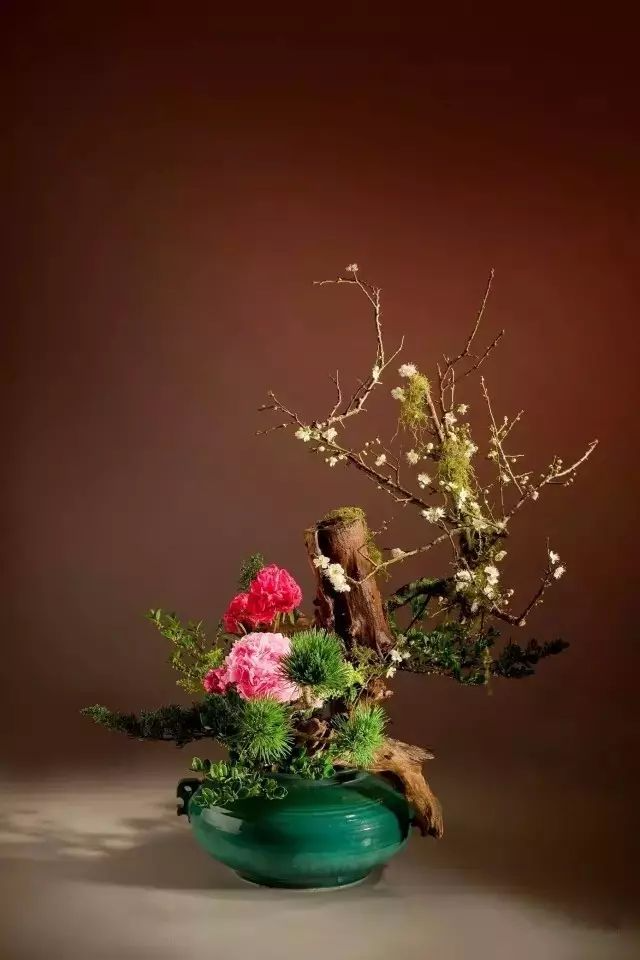
Elements of Forming and Application of Floral Modeling
01 Characteristics and concepts of plastic arts
Plastic arts are also known as spatial arts, which include painting, sculpture and architecture. Plastic arts refer to the basic elements that constitute the form. It mainly includes three parts: form, texture (texture) and color. Among them, form is the basis of plastic elements, and there are two types of abstract form and concrete form (i.e. natural form). Texture refers to the organizational texture structure of the surface of an object, including various crisscross, uneven, rough and smooth texture changes, which express people's feelings about the texture characteristics of the surface of the object. Texture is also called texture. Due to the different materials of the object, the organization, arrangement and structure of the surface are different, thus producing a sense of roughness, smoothness, softness and hardness. Texture is the characteristic of the surface of an object. People's perception of texture is generally based on touch, but due to people's long-term experience with tactile objects, they can visually feel the difference in texture without touching it. We call it visual texture.
Modeling is the artist's use of skilled techniques to deal with specific themes, engage in appropriate arrangements or processing, change the original appearance of nature, produce a new combination, and give the audience a pleasant feeling of "beauty". That is, through the organic arrangement of the shapes and colors of materials (materials), through the process of refining, selecting, imagining, transforming, exaggerating, etc., to create a "beautiful" form. This is what Lao Tzu called "creating a form that cannot be named."
02 Elements of Forming
1. Point
In the concept of geometry, a point only occupies a space, but has no area. But when we use a point as an element of visual expression, the point has areas of different sizes. The size, position and relationship of a point are the three elements of a point. A point is the basis of all forms and the focus of vision. Points have various sizes, shapes and colors, and they can also affect visual and psychological feelings differently due to the surrounding shapes or environment, color and light and dark contrast. A point is the smallest unit of modeling. There are big points, small points, thick points, thin points, soft points and hard points, such as baby's breath and white daisy. When arranged and combined, they can form lines, surfaces, blocks and bodies. Combined with the use of color functions, a variety of changes can be produced.
2. Line
The close combination of points forms a line. A line is the trajectory of the movement of points. It has the characteristics of direction and length. It is one of the most basic visual elements. There are straight lines, curves, angled lines, thick, thin, long, short, virtual, dark, etc. Straight lines give people a feeling of strength, stability, vitality, and strength. Curves are more flexible and stretchable than straight lines. In terms of composition, they often show a light and flowing beauty, giving people a feeling of melodious, soft, and light. An angled line indicates a turning point. A broken line or two lines intersect to form an angle. The angle is divided into right angles, acute angles, and obtuse angles. The angles formed give people a sense of direction such as rising, falling, and moving forward. An angled line is the easiest to express three-dimensional space. Linear flowers include Tailin, Equisetum, Lanye, Yunlongliu, etc.
3. Surface
The close combination of lines can form a surface, which has length and width but no thickness. The beauty of the surface is open and more holistic. In flower art, the plane is mostly leaves, showing the depth and stability of space. In terms of modeling, the state of the surface formation can be divided into plane, curved surface (softer than the plane), and polygonal surface according to our visual experience. Curved surface is softer than the plane, and there are two categories: convex curved surface and concave curved surface. In flower art applications, there are not many real flat materials. Most of the leaves or petals have concave and convex curved surface characteristics. Flower materials include telecommunication orchid, leaf orchid, mountain sedge, golden pothos, and golden plate.
4. Block
The feeling of blocks is the beauty of volume, form, and metamorphosis (combination of surfaces and lines). They are divided into large, small, loose, soft, hard, etc., such as dead wood, stone, and hydrangea. The surface block is a collection of surfaces into blocks. Blocks refer to solid solids that occupy three-dimensional space. "Quantity" is its characteristic. Blocks are divided into square blocks, spherical blocks, cylindrical blocks, cone blocks, polygonal blocks, etc. according to their shapes. Blocks are used in flower art, mainly fruits, to express the autumn mood and the feeling of abundance. Flowers such as pumpkin eggplant, ox-horn eggplant, and emperor flower can also be combined with many surface-shaped flowers, such as sunflowers, sunflowers, and leaf peonies. The typical block is solid in principle. In addition to the "shape and color" of the appearance, the texture has a great influence on the feeling of the block. The texture has softness and hardness, dryness and wetness, thickness and fineness, lightness and heaviness, etc. Most of them belong to the function of the tactile category. Dry hardness is one of the techniques to enhance the depth of modeling works. Common materials such as lotus pods, pine cones, gourds, pomegranates, coconuts, dead wood, and rocks are all commonly used dry hard block flower materials for flower modeling. Soft blocks refer to surfaces or polyhedrons with soft textures and nearly sealed appearances. For example, flowers include peony, hydrangea, fairy dan, Tang cotton, carnation, chopped green onion, cockscomb, cotton, baby's breath, fennel, etc.
5. Body
The body is a collection of many different points, lines, surfaces, and blocks. It is an organic combination of hollows, occupying space and containing space. The body formed by the combination of points and lines is a point-line body. Due to the changes in the virtuality, size, quantity, softness, hardness, thickness, length, straightness, weight, and brightness, as well as the brightness and turbidity of colors, a variety of shapes are produced. The point-line body is lighter and more ethereal. The flowers of the point-line body include small handballs, mountain return, snow willow, delphinium, marigold, June snow, moon peach, Murasaki Shikibu, etc. The surface-line body is a body formed by a combination of various surfaces and lines. Due to the characteristics of the surface material, the surface-line body can emphasize the depth and volume of the space more than the point-line body. The surface-line body can express a more stable and powerful shape, which has a lot to do with the density of the quantity. The body composed of block lines can better express the beauty of contrast in the shape due to its different materials and volume. The modeling of blocks and lines should emphasize the spatial relationship between the three scenes (foreground, middle ground and background) and the virtual and real.
The purpose of modeling is to skillfully use points, lines, surfaces and blocks in various plastic arts to express many different emotions and visual effects.
03 Principles of Beauty
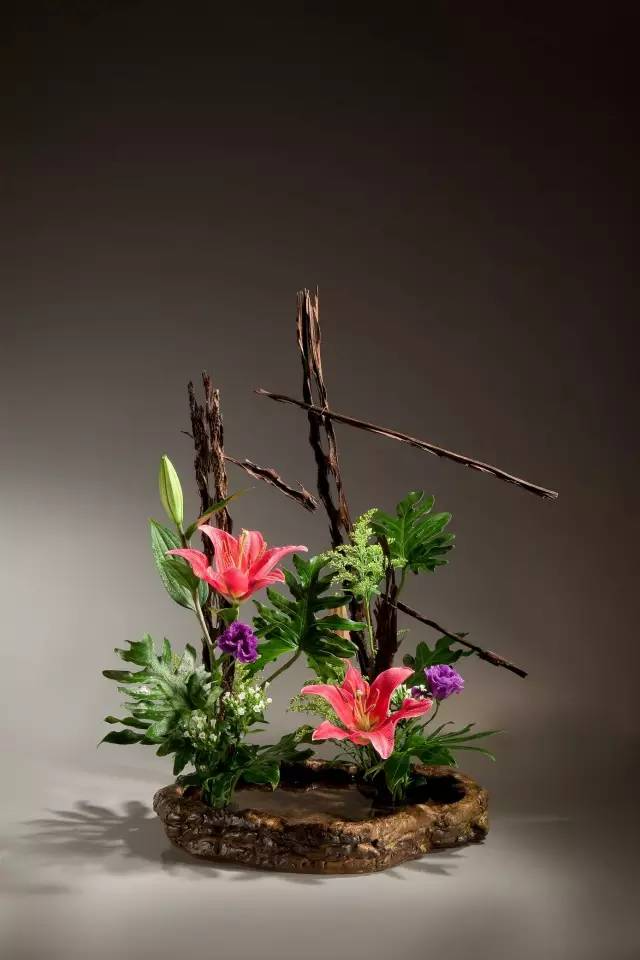
Polygonal surface
Flowers: Heliconia, Bird of Paradise, Mountain Sedge, Typhoon Grass, Giant Pineapple, Sunflower, Land Lotus
Flower pot: plate
Modeling flowers are a type of flower arrangement that creates a new and pure beauty based on aesthetic principles or beautiful forms. The points, lines, surfaces, blocks, and bodies of the materials are combined and transformed through the following principles to form a living organism. In application, attention should be paid to "unity in diversity". Diversity means change, and change can remove dullness and loneliness and generate interest. But if the change is infinite, it will become fragmented and scattered, with no direction to follow, forming a loose and messy situation. The principle of unity in diversity is to show simplicity in "change" and maintain "unity" in complexity.
1. Symmetry
An object is shaped like a circle with an invisible line as the central axis, up, down, left and right. It is called a symmetrical shape when the colors and textures are exactly the same, that is, the arrangement is equal on both sides of the axis. Symmetrical shapes usually have a simple and concise beauty and a sense of static stability. They are solemn, dignified, calm, eternally neat and magnificent, such as the symmetry of leaves, the symmetry of the human body, and the couplets in the hall.
2. Changes
Seek unity in change, and change in unity. Too much unity will create a monotonous feeling, and change is necessary to make it interesting. In the creation of flower arrangement, various components are carefully arranged using continuous change, interval change, alternating change, gradual change and other techniques, so that the work is uneven and well-arranged, with appropriate density, gathering and dispersion, and a balance of virtuality and reality, light and dark.
3. Proportion
A shape is a perfect ratio when its length, height, width, height, width, and width are in perfect relationship with each other and with the whole. For example, geometric progressions, square roots, and rectangles in mathematics are all beautiful ratios. The most beautiful ratio is called the "golden ratio", which is 1:1.618.
4. Gradient
It is a technique of expression that gradually increases, decreases, and becomes larger and smaller. The amount of shapes, colors, dots, lines, etc. used changes in an orderly manner, gradually increasing or decreasing, such as from large to small, from thick to thin, from dark to light (like gradient paper). In the changes of these levels, a soft and flowing beauty can be achieved.
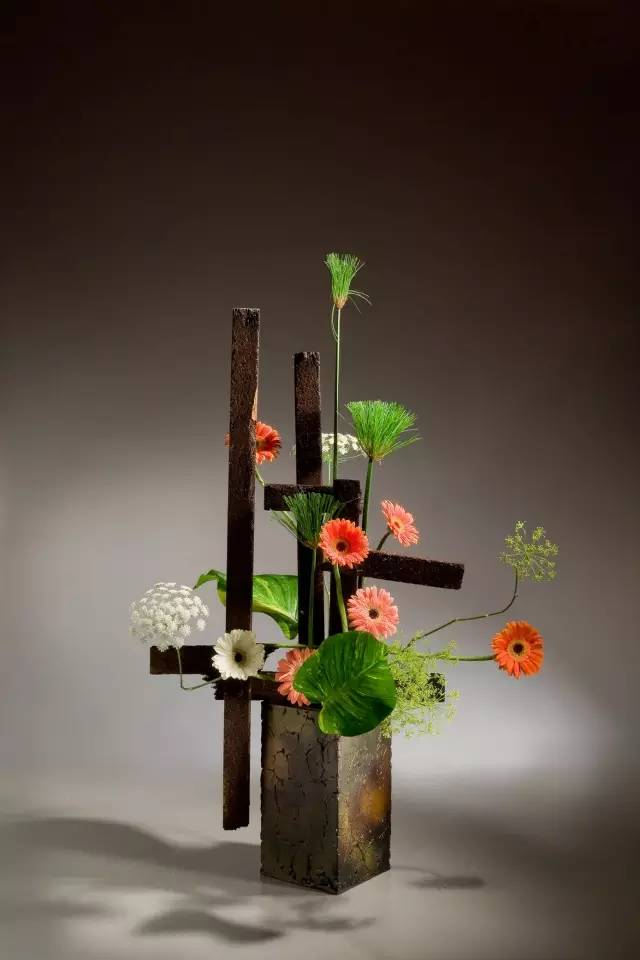
straight line
Flowers: snakewood, sunflower, fennel, golden pothos, sedge, lace flower
Flower pot: Creative pottery
5. Rhythm
Rhythm is also called rhythm or movement. It refers to the orderly movement of shapes, colors, dots and lines. The changes arranged by repetition, gradient, overlap and intricate lines will form a sense of rhythm visually and psychologically, making the work full of vitality, such as lines changing from thin to thick, and colors changing from light to dark.
6. Repeat
The same shapes, colors, etc. are repeated or appear continuously to achieve a rhythmic, harmonious, and unified aesthetic, such as sea waves and rice waves.
7. Contrast
Contrast refers to the difference that appears when two things are compared. Common forms of contrast include strength, lightness, density, size of shape, color intensity, reality and illusion, squareness and roundness, convexity and concaveness, length and shortness, width and narrowness, coldness and warmth of color, contrast between surfaces and lines, light and dark, clear and turbid, roughness and smoothness, softness and hardness, etc.
8. Complete
It is divided into static beauty of complete space and dynamic beauty of complete time. No matter which principle of beauty is used in any work of art, the artist pursues the "completeness" of the work at the moment of completion.
9. Emphasis
Emphasize a certain part or theme of the work. The emphasized part should occupy a larger proportion to strengthen the viewer's impression.
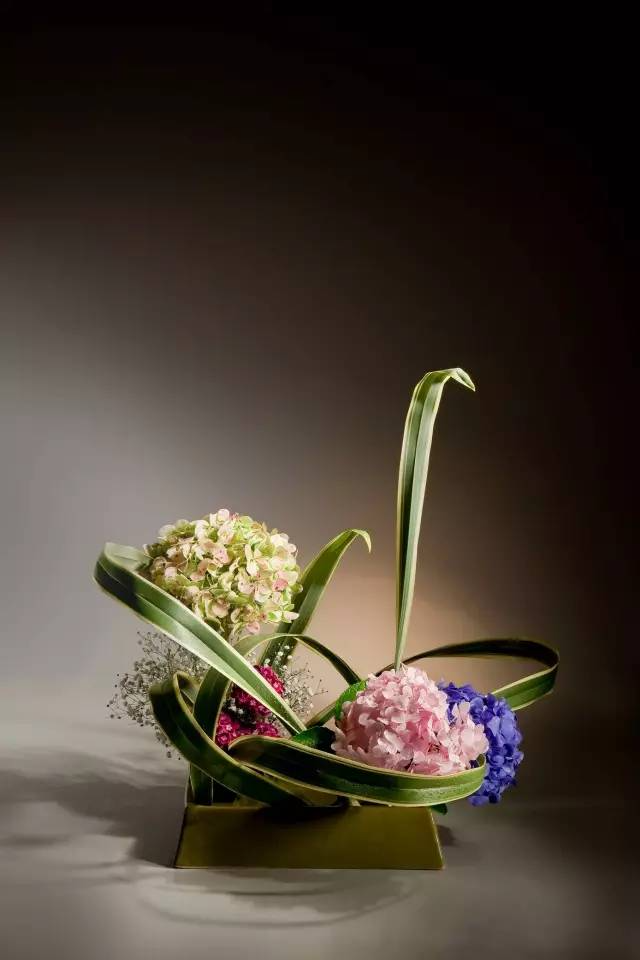
Block Line
Flowers: Hydrangea, New Zealand hemp, baby's breath, dianthus
Flower vase: Square plate
10. Harmony
Harmony is the common order of similar elements and small contrast, which makes the two reach a harmonious state. For example, black and white are a strong contrast, and the gray in between is the harmony of the two. In addition to color and shape, texture is also a very important factor in harmony. Shapes and colors, when combined together, give people a static, pleasant, gentle, harmonious and smooth feeling, which can relax our tense mood and achieve a calm and happy purpose.
11. Unification
Unity is to combine common elements, organize and sort out the same or similar forms, colors, textures and other elements in an orderly or unified manner. Among many complex factors such as shape, color, quality and quantity, the overall configuration must be selected, processed, carefully combined and inserted to achieve harmony and unity, so that the components are coordinated, complemented and reflected with each other, forming an organized, responsive and rhythmic organism, and finding a common point will prevent it from being loose.
12. Balance
In floral art, the word "balance" refers to visual balance. "Balance" means placing things of equal quality on both sides of the imaginary axis in the picture. In this way, although the things in the picture are not equal, they have the same weight in visual perception, which creates a sense of stability. There are three forms of balance: color balance, quantity balance, texture balance, and spatial balance.
04 How to express shaped flowers
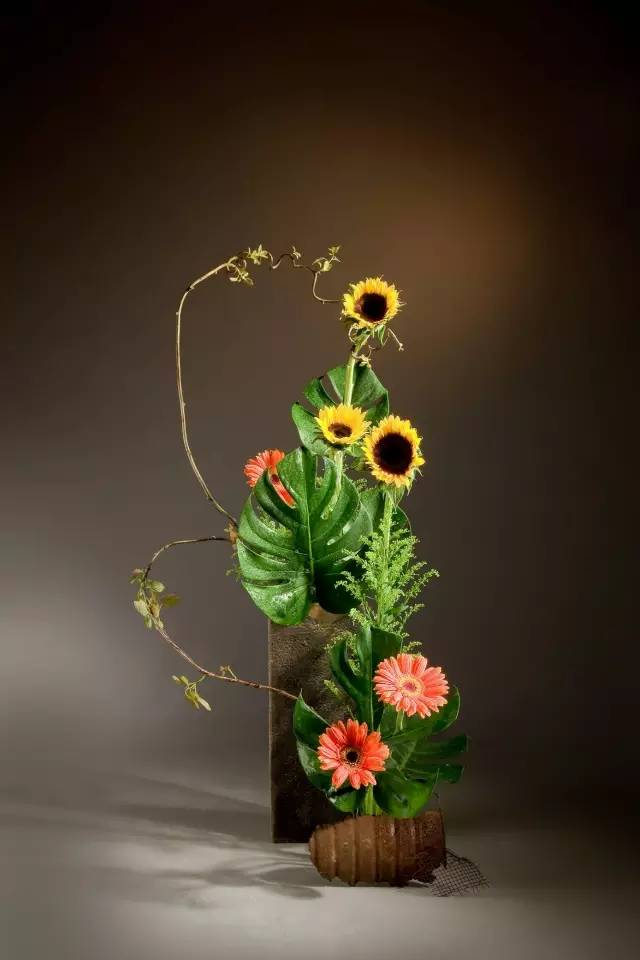
Surface line
Flowers: sunflower, telecommunication orchid, typhoon grass, monkey vine, sunflower, iron sheet
Flower pot: Creative pottery
The three main branches, the main branch, the guest branch, and the supporting branch, are the ones that beginners of Chinese flower art must understand and remember their proportions, directions, and positions. However, this is only a learning process. After practicing to a certain level, you will no longer be constrained by the basic form, and you will soon be able to complete a flower arrangement that is purely for the purpose of artistic "beauty" and has a style. At this time, it has no fixed form and can violate nature and create nature. Like the permutations and combinations in mathematics, it has a strong creative meaning and diversity, and has a strong sense of pleasure and education, which can be subtle and entertaining. It is decorative and has brighter colors. Therefore, although it is not easy to talk about the shape, the shape is "seen" and although it is not easy to talk about the meaning, the meaning is "present", which is the best portrayal of shaped flowers.
The illustrator chooses vases and flowers according to the theme he wants to express and combines them to create flower shapes. He also makes appropriate arrangements of the materials' quantity, texture, color, space and time. When making arrangements, he can use natural expression, design expression, abstract expression, symbolic expression and surreal expression techniques.
Natural expression is also called realistic expression. It combines the shapes, colors and postures of the material to flexibly present the individual and vivid beauty of the material. The expression of craftsmanship is more artificial. It decomposes the material, takes all or part of it, and forms a flower pattern, which is purely composed of shape and color. Abstract expression does not consider the natural order and nature of the material, but takes its shape, color and texture into consideration to create a work with rich sensuality. Symbolic expression is the subjective expression of the author, the author's association or other expression of ideas or emotions.
Whether a work resonates with people or not depends on the use of materials, so you must first cultivate your thinking ability, observe the materials again with your own eyes and senses, not stick to the sun-loving nature of plants and explore the composition of branches and leaves, extract the beauty of plants, namely the characteristics of points, lines, surfaces, blocks, bodies, quality, quantity, colors, etc., or take smaller unit parts from the unit parts of the plants (materials), or decompose and deform the materials and then recombine them.
The conception before creation is the biggest factor that determines the success or failure of the work. The conception can be started from the following aspects. In terms of materials, the materials are divided into natural, dry, and artificial. Plant materials can be inserted according to their natural postures. When dealing with points, lines, surfaces, blocks, and bodies, they can also be deformed, disintegrated, deteriorated, and colored before being inserted. Heterogeneous processed materials, such as iron wire, stone, dried flowers, artificial flowers, glass beads, etc. are also good materials for arranging shaped flowers. In terms of flower vases, flower vases are part of the flower shape and are integrated with the flower shape. The shapes are roughly divided into square, round, deformable, etc. Consider the shape, color, volume, texture, and taste of the utensil first, and then choose the flower material. In terms of the environment, the space where the work is placed is a flower exhibition venue, home decoration or window display, and the work must be in harmony with the environment. In terms of content, consider whether the work is decorative or interesting.
Works Appreciation
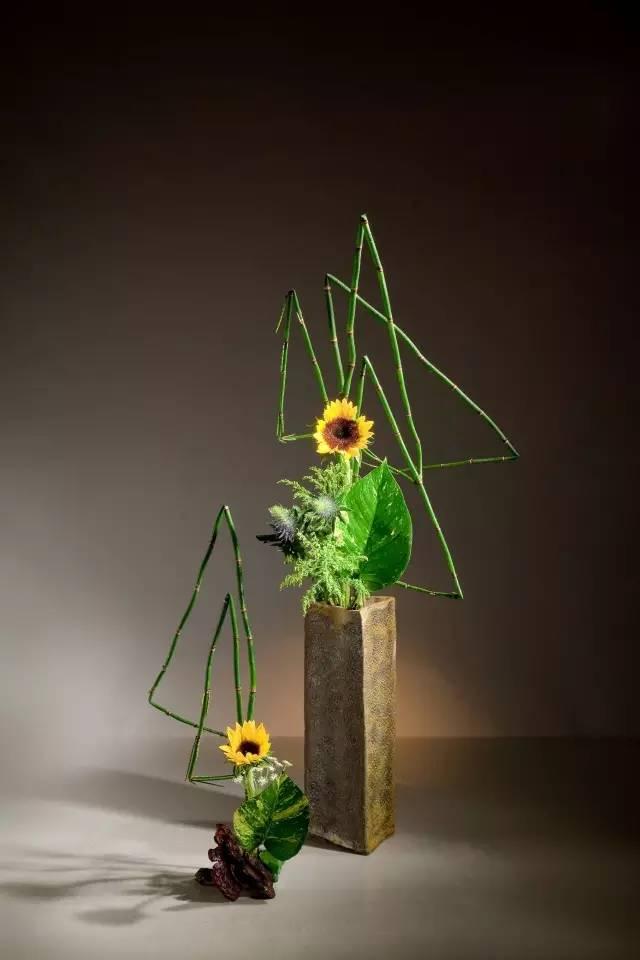
Corner Line
Flowers: horsetail, sunflower, typhoon grass, golden pothos, thistle, lace flower
Flower pot: Creative pottery
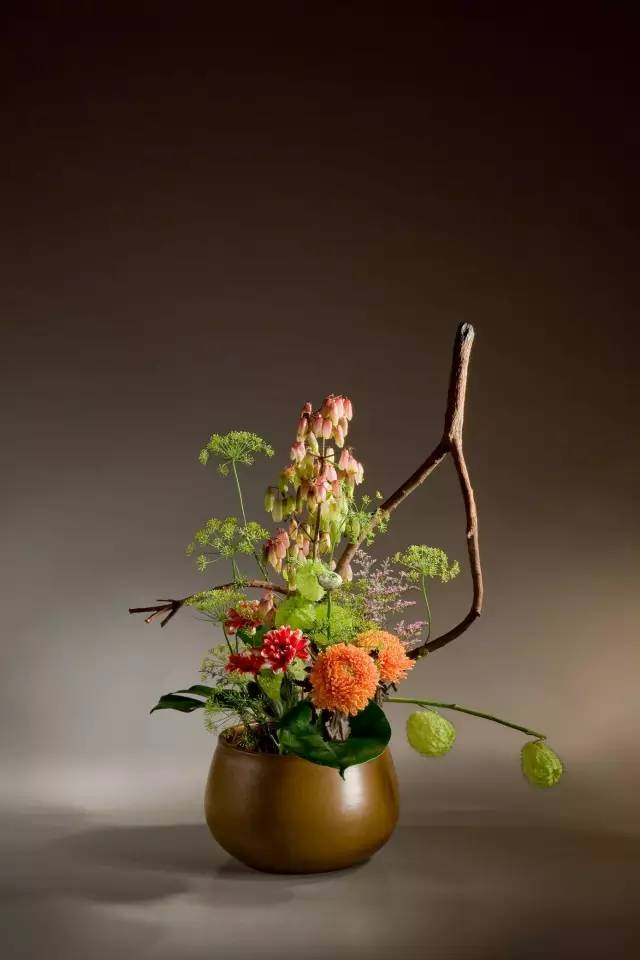
Soft block
Flowers: Floating roots, dead wood, fennel, cotton, dahlia, chrysanthemum, telecommunication orchid, small stone cistanche, land lotus
Flower pot: jar
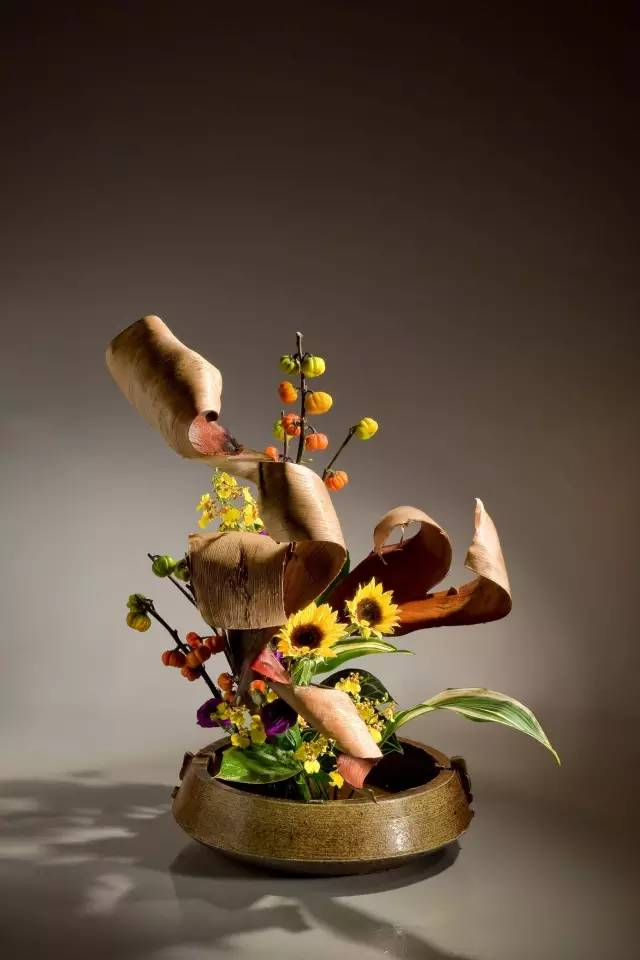
Surface
Flowers: coconut shell, eggplant, sunflower, orchid, candle leaf, oncidium, lisianthus
Flower vase: Pottery plate
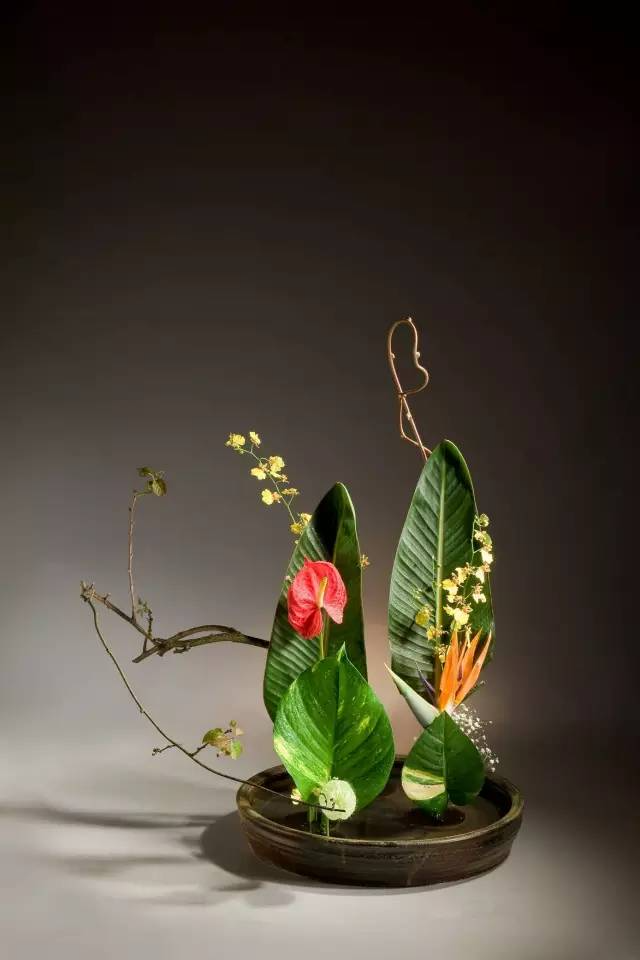
flat
Flowers: Bird of Paradise Leaves, Bird of Paradise, Monkey Vine, Flamingo, Oncidium, Golden Pothos, Tang cotton, Gypsophila paniculata
Flower pot: plate
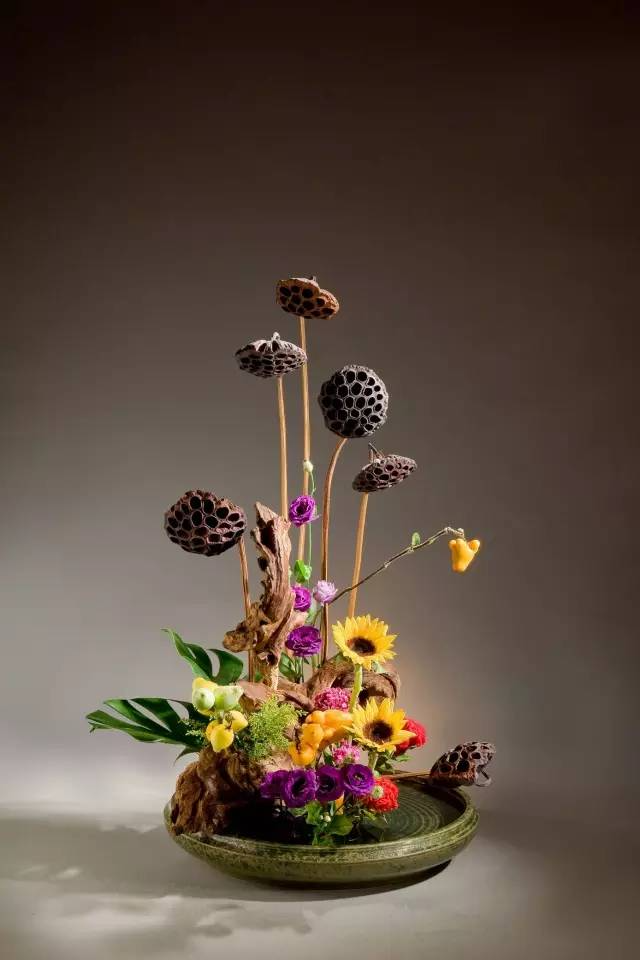
Dry lumps
Flowers: dried lotus, dead wood, eggplant, sunflower, cockscomb, lisianthus, telecommunication orchid, dianthus
Flower pot: plate

point
Flowers: Chinese tallow tree, pitaya, cotton tree, baby's breath, lotus, amaryllis, mountain sedge, dead wood